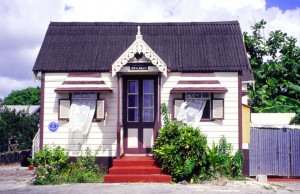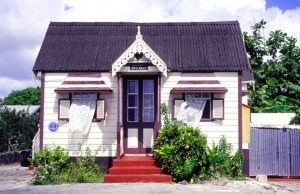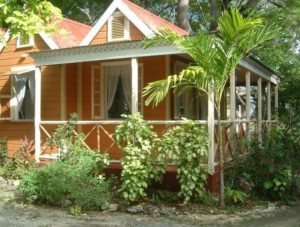
Its a Chattel House
In some parts of the Caribbean, there remain remnants of the plantation era, some of which include the housing structure. Even though they are not as prominent as in the 1800’s or early 1900’s the Chattel House still can been seen more in decorative and artistic structures today. The Chattel House was designed for the lifestyle of the plantation worker, where they were easily dismantled – almost like a life-size puzzle, and reassembled.
 In many cases it took just one day for these structures to be taken down, removed and mounted in a new location. This was of importance, especially if there arose a dispute between the plantation owner or landlord and the tenant (the worker). If unresolved and the tenant was asked to move forthwith then it was easy to gather a group of persons from within the village community to dismantle and reassemble in a new place.
In many cases it took just one day for these structures to be taken down, removed and mounted in a new location. This was of importance, especially if there arose a dispute between the plantation owner or landlord and the tenant (the worker). If unresolved and the tenant was asked to move forthwith then it was easy to gather a group of persons from within the village community to dismantle and reassemble in a new place.
The foundation structure of these buildings were simply coral stone blocks. The floor then become one piece of the puzzle then the four sides of the building followed by the roof. The roof was very steep or acute in its angle and considered a gable type roof. The angle of the roof was best suited for the Caribbean region which battle hurricane seasons annually. Therefore the roof’s angle acted to deflect the strong winds and heavy rains – and thus the loss in the property minimized.
These structures are so called since they can be moved and with ease as well. The window called a jalousie was also created to allow maximum air-flow through the building, and were quite effective. When it is closed the jalousie window still provided a barrier against any missiles in bad weather as these windows were made of wooden louvers.
In more recent times, persons have found secondary use of these chattel houses, such as to open their own small or micro business, such as t-shirt shops as well as boutiques and tuck shops. The house generally offers a square footage of around 1000 square feet or so. Therefore some business persons have also made use of the surrounding lands to support their respective cottage industry or virtual business.
Often times these Chattel Houses are easily identifiable, as they are generally painted in very rich or vibrant Caribbean Colors – pastels and exciting hues…but they may be still considered some bit of a risk as they are always wooden, even today.
In order to add some further characteristic to the usually simple structure, there may be some carved trimming around the roof or door or even the windows to give it a bit of exquisiteness. This adds value not only to the resident but also on the visual side.
Let’s see if these structures stand the test of time over the next half century.